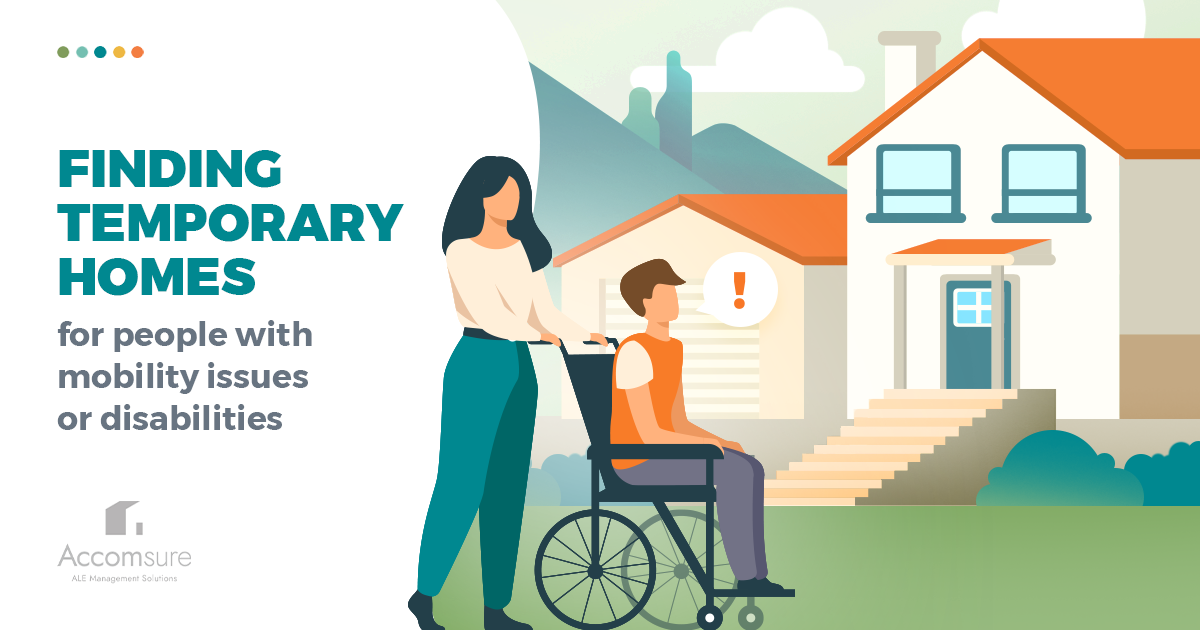After the loss of a home, finding a temporary place to live is often the first and most important concern of your policyholders. However, finding appropriate shelter can be much more difficult for some populations than others. While every policyholder has a unique set of needs, people living with disabilities often have a particularly difficult time finding appropriate temporary accommodation or a place to spend the night.
This article takes a look at the stats and trends regarding Canadians with disabilities, why they might have a more difficult time finding appropriate temporary accommodation, and the increased claim costs of rehousing policyholders with disabilities or mobility issues.
Canadian Disability Statistics and Disability Trends
Disabilities
According to Statistics Canada, 1 in 5 Canadians aged 15 and older had one or more disabilities in 2017. This represents about 6.2 million Canadians. It is expected that the actual number is likely much higher and the disability trend will continue to grow in the years to come.
Disabilities and Age
As people get older, they become more likely to be affected by disabilities. While only 13% of youth aged 15-24 years old are affected by disabilities, this percentage steadily increases through the age groups (Statistics Canada). 38% of seniors in Canada aged 65 and older have a disability.
As we discussed in our previous blog post, The Average Canadian: How The Demographics of Canada is Shifting, the life expectancy of Canadians has increased in this millennium, which has resulted in a growing population of seniors. Due to an increasingly aging population, the overall number of Canadians with disabilities is also expected to increase.

Mobility Issues
Of all the Canadians with disabilities, 10% have a mobility impairment. This is a type of disability that affects gross motor skills such as walking. Mobility disabilities are the 2nd most common type of disability, after pain-related disabilities and tied with flexibility disabilities. What does this mean? At least 10% of Canadians have trouble walking, which seriously limits their pool of temporary accommodation options. The unique needs of individuals with these disabilities would need to be taken into account when finding appropriate accommodation to ensure that they may continue to live independently.
Temporary Accommodation Challenges for Policyholders with Mobility Issues
Let’s face it, most homes are built for non-disabled people. Stairs, narrow doorways, and kitchens with high countertops can all be major obstacles for someone with mobility issues and can make it difficult for them to live independently. This makes finding appropriate accommodation particularly difficult.
Here are a few examples of the features a policyholder with disabilities may be looking for in a perfect temporary home:
- An accessible building entrance on an accessible path
- Wheelchair accessible doors
- An accessible path into the housing unit and inside the housing unit
- Light switches, electrical outlets, thermostats, etc. at an accessible height/ location
- Grab bars in the bathroom
- Sinks and countertops without cupboards underneath to allow for a wheelchair user to roll their legs underneath
- Countertops with a reduced height

As an adjuster who is already dealing with a heavy workload, it can be challenging to help your policyholders with more complex needs. At the same time, adhering to these requirements is important because it significantly affects the livelihood and independence of your policyholder.
Increased Claim Costs/ALE Costs of Rehousing Policyholders with Mobility Issues
Typically it is up to the policyholder to find temporary accommodation after losing their home. Even without mobility issues, finding appropriate accommodation that is within home insurance policy limits can be a huge undertaking. The longer it takes to find temporary accommodation, the more expensive the cost of the claim. This is usually due to the higher cost of hotel accommodation and the cost of eating out rather than cooking at home.
For individuals with mobility issues, it may take much longer to find acceptable accommodation, which further increases the cost of the claim. Also, if the temporary accommodation does not include a suitable kitchen space, a person with a mobility impairment may be unable to cook for themselves. This also contributes to an overall increased home insurance claim cost.
How Accomsure Can Help
At Accomsure, we understand adjusters’ desire to help policyholders to the best of your ability. We also know that your heavy workload often makes it difficult to provide your policyholders with all the support they need. Complex cases such as those involving persons with disabilities can also put an increased strain on an insurance company.
Accomsure can take care of your policyholder’s complex accommodation needs, so you can focus on what you do best: effectively managing the insurance claim. Accomsure has worked on many complex cases to quickly facilitating placement into temporary accommodations that not only meet the unique needs of the policyholders but also stay within the policy limits. We have an extensive list of industry contacts to draw on to find suitable accommodations for your policyholders every time.
You can easily submit a claim through our website, email or by calling us at 1.888.212.5815.




